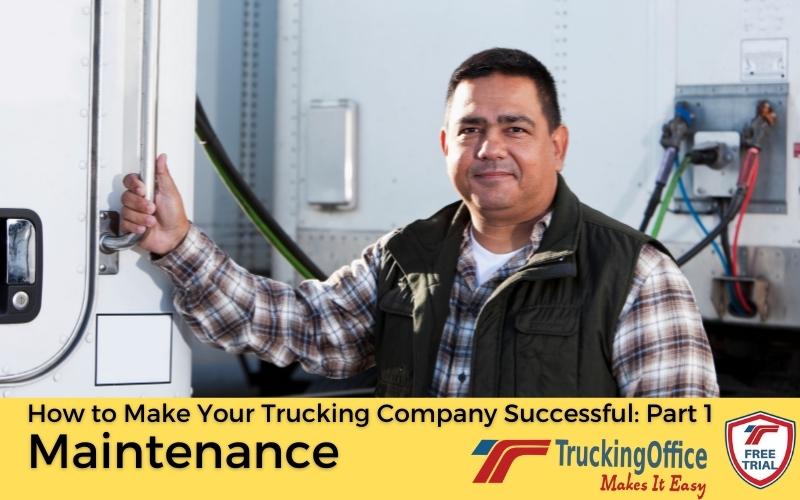Whether your trucking company has one truck or one thousand, you’ll have much fewer hassles and much more profit if you invest in preventative maintenance for your fleet. However, there’s far more to maintaining a rig than just talking about it. Proper maintenance means paying strict attention to schedules and having enough funds on-hand to make sure the job is done right. Sometimes, the only difference between heartbreak and a successful trucking company is maintenance.
The Right Mechanic
There’s nothing worse than the on-road emergency breakdown for a trucker who’s running on the edge of failure. One blown tire, one oil leak and a successful trucking company can be history. That’s why finding the right mechanic to service your rig is as important as finding an accountant to make sure your taxes are done right.
Plenty of truckers like to do their own maintenance. As long as it’s done right and on time, there’s a lot to be said for how much money a trucker will save. But when that’s not an option, finding a mechanic that you trust to handle those regular maintenance task like oil changes and brakes makes a huge difference.
You don’t have to depend on the dealer who sold you the rig, either. Sometimes the best mechanic is the guy in the sweaty t-shirt a few miles away from the highway. Ask around. The best guys have reputations. You’ll find them.
It’s All In The Manuals
Every commercial vehicle comes with instructions for getting the most use out of it; they’re in the manual. There you’ll find maintenance schedules, the proper oil and fluid levels, noise emission details, specifications for torque, and other vital information.
The charts offer different recommendations depending on many factors, such as how far you drive and the wear and tear the truck endures. To know what’s best for your rig, you’ll need to consider what kind of conditions you drive under. For example, if you’re running 80 mph most of the time, then you’ll need to perform more maintenance than if you average 65 mph.
In the same way, hauling heavy loads through the Rocky Mountains will do more to age your rig than transporting produce across the Great Plains. Most manuals offer a variety of maintenance schedules based on factors like these, so use the one that best fits your situation.
Basic vs. Advanced Maintenance
A list of the simplest (and least expensive) maintenance tasks include the following:
- Checking tires for wear and inflation levels.
- Changing engine oil at recommended intervals.
- Inspecting wipers and replacing as necessary.
- Making sure lights work correctly at all times.
- Replacing oil and other filters according to official maintenance schedules.
- Regularly inspecting belts and hoses for cracks or other signs of wear and replacing as necessary.
A more complete list will include tasks that may require the services of a professional mechanic:
- Servicing brakes.
- Checking and maintaining drive axles.
- Inspecting and maintaining wheel seals.
- Inspecting and maintaining the transmission.
- Checking the batteries.
- Checking and maintaining the exhaust system.
- Inspecting and servicing the driveline.
- Checking the suspension.
- Inspecting and maintaining the steering, clutch, and engine.
The Importance of a Maintenance Escrow Savings Account
Any independent trucker knows the meaning of the term “feast or famine.” Either you’re literally driving for days on end, or you’re sitting at home wondering if you’ll ever haul a load again. This being the case, it’s absolutely essential that you set aside funds during the good times so you’ll have cash on-hand for maintenance expenses during the lean times. Experts in trucking finance recommend putting money aside on a per-mile basis. Based on the age of your rig, you may consider setting aside as much as 15 cents per mile for maintenance.
Know When to Trade the Truck in
Nothing lasts forever. No matter how much you love your rig, the time will come when it’s time to say adios and get a newer one. Here are some tips for knowing when that day has arrived:
- When you’re not running the truck so much as it’s running you. If the costs of payments, operating expenses, and maintenance are greater than what you’re bringing in, then it’s time for a trip to the dealer.
- When the truck’s resale value offsets a newer vehicle’s principal and interest to a significant degree.
- When you’re scared stiff that the next DOT officer you run into will either fine the living daylights out of you or declare your rig unsafe for use.
The first two are simple mathematical computations, and the third is a subjective feeling. Nonetheless, all three are excellent indicators that trade-in time has come.
Trust TruckingOffice to be Your Owner-Operator Software
These days, having the right software is almost as important as having the right truck.
TruckingOffice features easy maintenance log entry screens, and can sort records by date, truck, cost, or vendor for specific repairs. It also helps you to create a preventative maintenance plan to send you alerts when it’s time for repairs and oil changes. That’s why we recommend you take TruckingOffice for a free test drive. Once you do, you’ll wonder how you ever got along without it. Try it out today!







Recent Comments